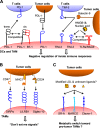Myeloid immunosuppression and immune checkpoints in the tumor microenvironment
- PMID: 31611651
- PMCID: PMC6952382
- DOI: 10.1038/s41423-019-0306-1
Myeloid immunosuppression and immune checkpoints in the tumor microenvironment
Abstract
Tumor-promoting inflammation and the avoidance of immune destruction are hallmarks of cancer. While innate immune cells, such as neutrophils, monocytes, and macrophages, are critical mediators for sterile and nonsterile inflammation, persistent inflammation, such as that which occurs in cancer, is known to disturb normal myelopoiesis. This disturbance leads to the generation of immunosuppressive myeloid cells, such as myeloid-derived suppressor cells (MDSCs) and tumor-associated macrophages (TAMs). Due to their potent suppressive activities against effector lymphocytes and their abundance in the tumor microenvironment, immunosuppressive myeloid cells act as a major barrier to cancer immunotherapy. Indeed, various therapeutic approaches directed toward immunosuppressive myeloid cells are actively being tested in preclinical and clinical studies. These include anti-inflammatory agents, therapeutic blockade of the mobilization and survival of myeloid cells, and immunostimulatory adjuvants. More recently, immune checkpoint molecules expressed on tumor-infiltrating myeloid cells have emerged as potential therapeutic targets to redirect these cells to eliminate tumor cells. In this review, we discuss the complex crosstalk between cancer-related inflammation and immunosuppressive myeloid cells and possible therapeutic strategies to harness antitumor immune responses.
Keywords: immune checkpoint; inflammation; innate immunity; macrophage; myeloid.
Conflict of interest statement
M.J.S has research agreements with Bristol Myers Squibb and Tizona Therapeutics and is a member of the Scientific Advisory Board (SAB) for Tizona Therapeutics and Compass Therapeutics.
Figures


References
-
- O’Donnell JS, Teng MWL, Smyth MJ. Cancer immunoediting and resistance to T cell-based immunotherapy. Nat. Rev. Clin. Oncol. 2019;16:151–167. - PubMed
-
- Dvorak HF. Tumors: wounds that do not heal. Similarities between tumor822 stroma generation and wound healing. N. Engl. J. Med. 1986;315:1650–1659. - PubMed
-
- Junttila MR, de Sauvage FJ. Influence of tumour micro-environment heterogeneity on therapeutic response. Nature. 2013;501:346. - PubMed
-
- Balkwill F, Mantovani A. Inflammation and cancer: back to Virchow? Lancet. 2001;357:539–545. - PubMed
Publication types
MeSH terms
Substances
LinkOut - more resources
Full Text Sources
Medical

